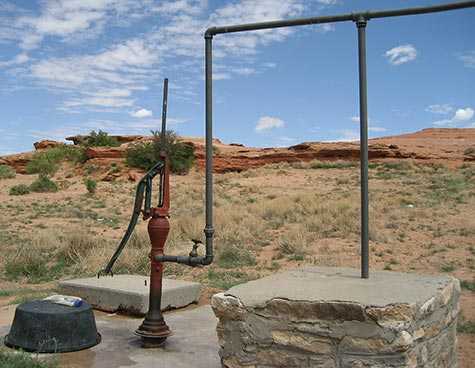Background on Private Water and Public Health
What Are Private Water Sources?

Hand pump well in a remote area on a Navajo reservation.
Private drinking water sources include
- Private wells,
- Springs,
- Cisterns,
- Water storage tanks, and
- Trucked water.
About 1 in 9 American residents get their drinking water from private wells. These water sources may have contaminants that can make them sick.
Can Private Water Sources Cause Health Problems?
Yes. Private water sources are not always treated to remove contaminants. In addition, because they are not covered by the Safe Drinking Water Act, these sources may not be tested regularly for disease-causing pathogens or chemicals. Without regular testing, people may be exposed to things that can make them sick without knowing it or being able to do anything about it.
What Contaminants Might Be in Private Drinking Water Sources?
Contaminants such as germs, chemicals, or radionuclides can contaminate wells and other private drinking water sources. These contaminants can cause a variety of health problems. Below is a list of common contaminants with links to the health effects that each cause.
Microbiological |
Chemical |
Radiological |
Note: Fluorides are naturally occurring compounds. Low levels of fluorides can help prevent dental cavities. High levels can cause fluorosis.

How Do Contaminants Get Into Private Drinking Water Sources?
Water sources can become contaminated in a variety of ways. Some regions are prone to high levels of certain contaminants in rock or soil that dissolve into water sources. For example, the northeastern part of the United States has high levels of naturally occurring arsenic in local rock formations that can leach into the water during the process of drilling and constructing the well. Other times, pathogens from farm animals can infiltrate poorly designed or lined wells and enter groundwater used for drinking. In addition, flooding and other emergencies can introduce contaminants to wells, springs, and other individual water sources.
What Is Our Unique Role in this Work?
We fund state and local health departments that serve communities and populations using small drinking water systems (for example, private wells, springs, cisterns). These sources are not covered by the federal Safe Drinking Water Act, which focuses on public water systems. Through our Safe WATCH program, we fund health departments to
- Identify and close program performance gaps,
- Increase use of efficient practices among drinking water programs,
- Increase the services reach of drinking water programs, and
- Reduce exposures to waterborne contaminants.
- Page last reviewed: April 25, 2016
- Page last updated: April 25, 2016
- Content source:


 ShareCompartir
ShareCompartir